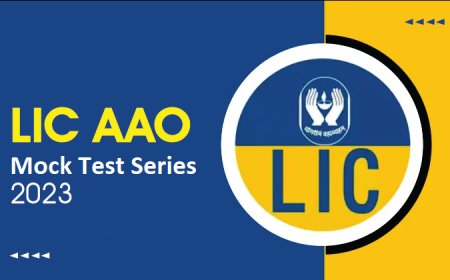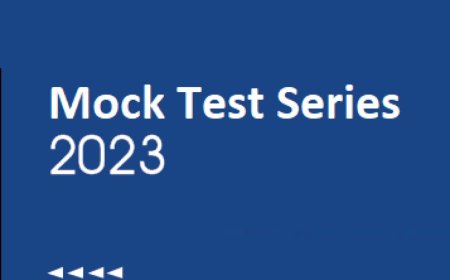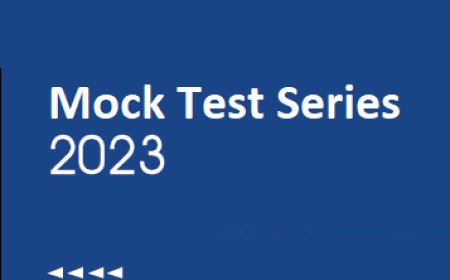LIC AAO - Reasoning Ability (Mock Test)
Reasoning Ability (Mock Test)
Direction: In the following question assuming the given statements to be true, find which of the conclusion among given some conclusion is/are definitely true and then give your answers accordingly:
Statement:
Z < E > A > L = P ≥ R ≤ T = F < U < H = G ≥ C > B = Y
Conclusions:
I. Z < F
II. F > Y
- Only conclusion I is true
- Only conclusion II is true
- Both conclusion I and II are true
- Neither conclusion I nor II is true
- Either I or II is true
Solution
Statement:
Z < E > A > L = P ≥ R ≤ T = F < U < H = G ≥ C > B = Y
Conclusions:
I. Z < F → False (Z < E > A > L = P ≥ R ≤ T = F → No definite relation between the two can be determined)
II. F > Y → False (F < U < H = G ≥ C > B = Y → No definite relation between the two can be determined)
Hence, Neither conclusion I nor II is true.
Directions: In the following question, assume the given statements to be true, find which of the conclusions among given conclusions is/are definitely true, and then give your answers accordingly.
Statements: W > B > H > N; L > J > K > N
Conclusions:
I. L > B
II. H > J
- Only I follow
- Only II follow
- Both I and II follow
- Either I or II follow
- Neither I nor II follow
Solution
Given statements: W > B > H > N; L > J > K > N
On combining: W > B > H > N < K < J < L
Conclusions:
I. L > B → False (On combining the two statements we get W > B > H > N < K < J < L, as there is no definite path the conclusion L > B is false)
II. H > J → False (On combining the two statements we get W > B > H > N < K < J < L, as there is no definite path the conclusion H > J is false)
Hence, Neither I nor II follow is the correct answer.
Directions:- Read the following comprehension carefully and answer the questions given below.
Seven people A, B, C, K, L, M, and N are sitting around a circular table and all of them are facing inside the table. K is sitting second to the right of A. Only two people are sitting between K and L. M sits third to the right of N. N is an immediate neighbor of K and only one person is sitting between L and N. Only two people are sitting between A and C. B is not an immediate neighbor of K.
Question:
What is the position of C with respect to B?
- Second to the left
- Fourth to the right
- Fifth to the left
- Both I and II
- Both I and III
Directions:- Read the following comprehension carefully and answer the questions given below.
Seven people A, B, C, K, L, M, and N are sitting around a circular table and all of them are facing inside the table. K is sitting second to the right of A. Only two people are sitting between K and L. M sits third to the right of N. N is an immediate neighbor of K and only one person is sitting between L and N. Only two people are sitting between A and C. B is not an immediate neighbor of K.
Question:
Who is sitting immediate right of A?
- L
- M
- N
- C
- B
Directions:- Read the following comprehension carefully and answer the questions given below.
Seven people A, B, C, K, L, M, and N are sitting around a circular table and all of them are facing inside the table. K is sitting second to the right of A. Only two people are sitting between K and L. M sits third to the right of N. N is an immediate neighbor of K and only one person is sitting between L and N. Only two people are sitting between A and C. B is not an immediate neighbor of K.
Question:
As many people are sitting between A and K from right of A sitting between B and ___ , from right of B?
- L
- K
- M
- N
- A
Directions: In the question below are given two statements followed by two conclusions numbered I and II. You have to take the given statements to be true even if they seem to be at variance with commonly known facts. Read all the conclusions and then decide which of the given conclusions logically follows from the given statements disregarding commonly known facts.
Statement-I: Only a few Pencil are Pen.
Statement-II: Few Box are Pen.
Statement-III: Only a few Rubbers are Pen.
Conclusion-I: Some Rubbers are Pencil.
Conclusion-II: Some Box are not Pencil.
- Only I follows
- Only II follows
- Either I or II follows
- Neither I nor II follows
- Both I and II follow
DIRECTIONS: In the question below are given two statements followed by two conclusions. You have to take the given statements to be true even if they seem to be at variance with commonly known facts. Read all the conclusions and then decide which of the given conclusions logically follows from the given statements disregarding the commonly known facts.
Statements :
All land are ground.
All big are land.
Only a few big are pond.
Conclusion :
I. Some ground are pond.
II. Some pond are land.
- Only conclusion I follows
- Only conclusion II follows
- Either conclusion I or II follows
- Neither conclusion I nor II follows
- Both conclusion I and II follow
DIRECTIONS: In the question below are given two statements followed by two conclusions. You have to take the given statements to be true even if they seem to be at variance with commonly known facts. Read all the conclusions and then decide which of the given conclusions logically follows from the given statements disregarding the commonly known facts.
Statements :
All land are ground.
All big are land.
Only a few big are pond.
Conclusion :
I. Some ground are pond.
II. Some pond are land.
- Only conclusion I follows
- Only conclusion II follows
- Either conclusion I or II follows
- Neither conclusion I nor II follows
- Both conclusion I and II follow
Comprehension:(Que No. 9 - 12)
Directions: Study the following information carefully and answer the questions given below.
Eight persons- A, B, C, D, E, F, G and H, are sitting in a linear row, but not necessarily in the same order. Four persons face towards North and the rest face towards South. Not more than two adjacent persons face the same direction. G sits second to the left of E, where both face the same direction. Only two people sit between E and F. Both F and G are not immediate neighbors. C sits immediately to the left of G. F doesn't sit at any of the ends of the row. A sits second to the right of B, where both face the same direction. B faces the opposite direction of G. Only four people sit between A and D. The immediate neighbors of F face the same direction. F faces the opposite direction of A. C doesn't face toward the South.
Question:
Four of the following five are alike in a certain way as per the given arrangement and hence form a group. Find the one who doesn't belong to that group.
- A
- C
- B
- H
- D
Comprehension:(Que No. 9 - 12)
Directions: Study the following information carefully and answer the questions given below.
Eight persons- A, B, C, D, E, F, G and H, are sitting in a linear row, but not necessarily in the same order. Four persons face towards North and the rest face towards South. Not more than two adjacent persons face the same direction. G sits second to the left of E, where both face the same direction. Only two people sit between E and F. Both F and G are not immediate neighbors. C sits immediately to the left of G. F doesn't sit at any of the ends of the row. A sits second to the right of B, where both face the same direction. B faces the opposite direction of G. Only four people sit between A and D. The immediate neighbors of F face the same direction. F faces the opposite direction of A. C doesn't face toward the South.
Question:
Who is second to the left of B?
- A
- F
- D
- G
- C
Comprehension:(Que No. 9 - 12)
Directions: Study the following information carefully and answer the questions given below.
Eight persons- A, B, C, D, E, F, G and H, are sitting in a linear row, but not necessarily in the same order. Four persons face towards North and the rest face towards South. Not more than two adjacent persons face the same direction. G sits second to the left of E, where both face the same direction. Only two people sit between E and F. Both F and G are not immediate neighbors. C sits immediately to the left of G. F doesn't sit at any of the ends of the row. A sits second to the right of B, where both face the same direction. B faces the opposite direction of G. Only four people sit between A and D. The immediate neighbors of F face the same direction. F faces the opposite direction of A. C doesn't face toward the South.
Question:
Who among the following persons sit to the immediate right of H?
- F
- A
- B
- G
- C
Direction: Read the following and answer the given questions:
Seven persons A, B, C, D, E, F, and G are going to attend a webinar on seven different days of the week (Monday to Sunday) but not necessarily in the same order.
More than three persons go before D, who does not go on Sunday. One person goes between D and F. F goes before D. B goes one of the days after C but not just after. B and E do not go on Sunday and A goes just before C. C goes on Tuesday. Neither B nor D goes on the second last day of the week. E goes just before G.
Question:
How many persons go between C and D?
- Two
- Four
- Three
- Five
- Other than those given as option
Solution
Seven persons A, B, C, D, E, F, and G.
Days: Monday, Tuesday, Wednesday, Thursday, Friday, Saturday, and Sunday.
1. C goes on Tuesday.
2. A goes just before C.
3. More than three persons go before D, who does not go on Sunday.
There are two cases for this statement.
|
Days |
Persons |
|
|
|
Case - 1 |
Case - 2 |
|
Monday |
A |
A |
|
Tuesday |
C |
C |
|
Wednesday |
|
|
|
Thursday |
|
|
|
Friday |
D |
|
|
Saturday |
|
D |
|
Sunday |
|
|
4. One person goes between D and F. F goes before D.
|
Days |
Persons |
|
|
|
Case - 1 |
Case - 2 |
|
Monday |
A |
A |
|
Tuesday |
C |
C |
|
Wednesday |
F |
|
|
Thursday |
|
F |
|
Friday |
D |
|
|
Saturday |
|
D |
|
Sunday |
|
|
5. Neither B nor D goes on the second last day of the week.
case- 2 gets eliminated.
6. B and E do not go on Sunday. B goes one of the days after C but not just after.
7. E goes just before G.
|
Days |
Persons |
|
|
Case - 1 |
|
Monday |
A |
|
Tuesday |
C |
|
Wednesday |
F |
|
Thursday |
B |
|
Friday |
D |
|
Saturday |
E |
|
Sunday |
G |
Hence, Two persons go between C and D.
Direction: Read the following and answer the given questions:
Seven persons A, B, C, D, E, F, and G are going to attend a webinar on seven different days of the week (Monday to Sunday) but not necessarily in the same order.
More than three persons go before D, who does not go on Sunday. One person goes between D and F. F goes before D. B goes one of the days after C but not just after. B and E do not go on Sunday and A goes just before C. C goes on Tuesday. Neither B nor D goes on the second last day of the week. E goes just before G.
Question:
Who among the following person goes on sunday?
- G
- D
- B
- F
- Other than those given as option
Solution
Seven persons A, B, C, D, E, F, and G.
Days: Monday, Tuesday, Wednesday, Thursday, Friday, Saturday, and Sunday.
1. C goes on Tuesday.
2. A goes just before C.
3. More than three persons go before D, who does not go on Sunday.
There are two cases for this statement.
|
Days |
Persons |
|
|
|
Case - 1 |
Case - 2 |
|
Monday |
A |
A |
|
Tuesday |
C |
C |
|
Wednesday |
|
|
|
Thursday |
|
|
|
Friday |
D |
|
|
Saturday |
|
D |
|
Sunday |
|
|
4. One person goes between D and F. F goes before D.
|
Days |
Persons |
|
|
|
Case - 1 |
Case - 2 |
|
Monday |
A |
A |
|
Tuesday |
C |
C |
|
Wednesday |
F |
|
|
Thursday |
|
F |
|
Friday |
D |
|
|
Saturday |
|
D |
|
Sunday |
|
|
5. Neither B nor D goes on the second last day of the week.
case- 2 gets eliminated.
6. B and E do not go on Sunday. B goes one of the days after C but not just after.
7. E goes just before G.
|
Days |
Persons |
|
|
Case - 1 |
|
Monday |
A |
|
Tuesday |
C |
|
Wednesday |
F |
|
Thursday |
B |
|
Friday |
D |
|
Saturday |
E |
|
Sunday |
G |
Hence, G goes on Sunday.
Direction: Read the following and answer the given questions:
Seven persons A, B, C, D, E, F, and G are going to attend a webinar on seven different days of the week (Monday to Sunday) but not necessarily in the same order.
More than three persons go before D, who does not go on Sunday. One person goes between D and F. F goes before D. B goes one of the days after C but not just after. B and E do not go on Sunday and A goes just before C. C goes on Tuesday. Neither B nor D goes on the second last day of the week. E goes just before G.
Question:
If A is related o F and B is related to E then D is related to which of the following?
- C
- E
- G
- B
- Other than those given as option
Solution
Seven persons A, B, C, D, E, F, and G.
Days: Monday, Tuesday, Wednesday, Thursday, Friday, Saturday, and Sunday.
1. C goes on Tuesday.
2. A goes just before C.
3. More than three persons go before D, who does not go on Sunday.
There are two cases for this statement.
|
Days |
Persons |
|
|
|
Case - 1 |
Case - 2 |
|
Monday |
A |
A |
|
Tuesday |
C |
C |
|
Wednesday |
|
|
|
Thursday |
|
|
|
Friday |
D |
|
|
Saturday |
|
D |
|
Sunday |
|
|
4. One person goes between D and F. F goes before D.
|
Days |
Persons |
|
|
|
Case - 1 |
Case - 2 |
|
Monday |
A |
A |
|
Tuesday |
C |
C |
|
Wednesday |
F |
|
|
Thursday |
|
F |
|
Friday |
D |
|
|
Saturday |
|
D |
|
Sunday |
|
|
5. Neither B nor D goes on the second last day of the week.
case- 2 gets eliminated.
6. B and E do not go on Sunday. B goes one of the days after C but not just after.
7. E goes just before G.
|
Days |
Persons |
|
|
Case - 1 |
|
Monday |
A |
|
Tuesday |
C |
|
Wednesday |
F |
|
Thursday |
B |
|
Friday |
D |
|
Saturday |
E |
|
Sunday |
G |
One person between A and F, B and E.
Hence, D is related to G.
Directions: Read carefully the information give below and answer the following questions.
There are eight members in a three generation family i.e. Rishu, Rohan, Preeti, Priya, Manas, Prince, Suraj, and Manoj. There are two married couple in the family. Manas is the brother of Rishu. Rohan is the husband of Preeti. Priya is married to Prince and Priya is the daughter of Rohan. Suraj is the sister of Manoj and Manoj is the brother of Manas. Manas is the son of Prince.
Question:
How Suraj is related to Prince?
- Daughter
- Son
- Mother
- Mother-in-law
- Data inadequate
Directions: Read carefully the information give below and answer the following questions.
There are eight members in a three generation family i.e. Rishu, Rohan, Preeti, Priya, Manas, Prince, Suraj, and Manoj. There are two married couple in the family. Manas is the brother of Rishu. Rohan is the husband of Preeti. Priya is married to Prince and Priya is the daughter of Rohan. Suraj is the sister of Manoj and Manoj is the brother of Manas. Manas is the son of Prince.
Question:
How Rishu is related to Priya?
- Son
- Daughter
- Sister
- Daughter-in-law
- Data inadequate
Directions: Read carefully the information give below and answer the following questions.
There are eight members in a three generation family i.e. Rishu, Rohan, Preeti, Priya, Manas, Prince, Suraj, and Manoj. There are two married couple in the family. Manas is the brother of Rishu. Rohan is the husband of Preeti. Priya is married to Prince and Priya is the daughter of Rohan. Suraj is the sister of Manoj and Manoj is the brother of Manas. Manas is the son of Prince.
Question:
If Rishu is Wife of Puja, then How Rishu is related to Manoj?
- Mother
- Father
- Brother
- Sister
- None of these
Directions: Study the following information and answer the given questions:
Band and Bob are standing in a row, where Band is 18th from the left end of the row and Bob is 24th from the right end of the row. If both of them interchange their positions, then Band becomes 30th from the left end.
Question:
Find the new position of Bob from the right end?
- 34
- 35
- 38
- 37
- None of these
Solution
Position of Band from the left end: 18th
Position of Bob from the right end: 24th
Hence, we can conclude,
There are 17 persons before Band and 23 persons after Bob.
If the position of Band and Bob is interchanged,
Position of Band from the left end: 30th
Hence, we can conclude that there are 29 persons standing before Bob.
The total number of persons in the row: 29 + 24 = 53
The new position of Bob is Band's previous position,
Since Band was 18th from the left end and there are 53 persons in the row, there are 35 peoples (53 - 18) are standing after Band.
Hence, Band is 36th from the right end and so Bob in the case.
Hence, None of these is the correct answer.
Directions: Study the following information and answer the given questions:
Band and Bob are standing in a row, where Band is 18th from the left end of the row and Bob is 24th from the right end of the row. If both of them interchange their positions, then Band becomes 30th from the left end.
Question:
Find the number of peoples in the row?
- 52
- 53
- 51
- 54
- Cannot be determined
Solution
Position of Band from the left end: 18th
Position of Bob from the right end: 24th
Hence, we can conclude,
There are 17 persons before Band and 23 persons after Bob.
If the position of Band and Bob is interchanged,
Position of Band from the left end: 30th
Hence, we can conclude that there are 29 persons standing before Bob.
The total number of persons in the row: 29 + 24 = 53
Hence, 53 is the correct answer.





